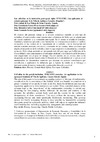Please use this identifier to cite or link to this item:
https://accedacris.ulpgc.es/jspui/handle/10553/58153
| Title: | Las cofradías en la institución parroquial, siglos XVII-XVIII. Una aplicación al señorío episcopal de la Villa de Agüimes, Canarias (España) | Other Titles: | Cofradias in the parish institution, XVII-XVIII centuries. An application to the episcopal dominion of Villa de Aguimes, Canary Islands (Spain) | Authors: | Castro Pérez, Candelaria Calvo Cruz, Mercedes Granado Suárez, Sonia |
UNESCO Clasification: | 5303 Contabilidad económica | Keywords: | Historia de la contabilidad Parroquias Cofradías History Accounting, et al |
Issue Date: | 2008 | Journal: | Procesos Historicos-Revista Semestral De Historia Arte Y Ciencias Sociales | Abstract: | El objetivo del presente trabajo es el estudio económico-contable de este tipo de cofradías, al considerarlas como asociaciones voluntarias de fieles que se erigían para dar mayor esplendor a la institución parroquial. En el mismo se estudia el concepto, finalidad y normativa aplicable a esta institución. A continuación se realiza un análisis exhaustivo de las cuentas de la mayordomía de la cofradía, con la descripción del método contable utilizado, estructura y contenido de las cuentas, libros auxiliares que emplea el mayordomo de la cofradía y motivos que originaron su decadencia y posterior extinción. Este trabajo pretende ser un ejemplo más del gran auge que la Historia de la Contabilidad y más concretamente el subcampo dedicado a la Contabilidad Eclesiástica está adquiriendo con el paso del tiempo. En este sentido, en los últimos años se ha despertado un incipiente interés sobre la Historia de la Contabilidad de la Iglesia al ser innumerables los documentos contables que atesoran los archivos eclesiásticos que contribuirán a explicarnos la influencia que la Iglesia ha tenido en el hallazgo e instrumentación de nuevas técnicas de organización, dirección y control. The aim of this paper is the economic-accounting analysis of this type of confraternity, considered to be an association of the faithful, which was founded to contribute to a greater splendour of the parish. In order to do this, firstly the definition, purposes and regulations applicable to these institutions are studied. Then, a detailed analysis of the accounts kept by the "mayordomo" of the confraternities (cofradias) is carried out, describing the book-keeping method followed, the structure and contents of the accounts, the subsidiary account books used and the reasons for the decline and disappearance of these associations. This study reflects the increasing interest in Accounting History and, more specifically, Ecclesiastic Accounting. This growing interest in Church Accounting History is made possible by innumerable accounting documents stored in ecclesiastic archives, which will help us to explain the influence that Church has had on finding organization, management and control practices. |
URI: | https://accedacris.ulpgc.es/handle/10553/58153 | ISSN: | 1690-4818 | Source: | Procesos históricos: revista de historia, arte y ciencias sociales[ISSN 1690-4818] (13), p. 1 | URL: | http://dialnet.unirioja.es/servlet/articulo?codigo=2580288 |
| Appears in Collections: | Artículos |
WEB OF SCIENCETM
Citations
1
checked on Feb 25, 2024
Page view(s)
70
checked on Nov 1, 2024
Download(s)
476
checked on Nov 1, 2024
Google ScholarTM
Check
Share
Export metadata
Items in accedaCRIS are protected by copyright, with all rights reserved, unless otherwise indicated.
